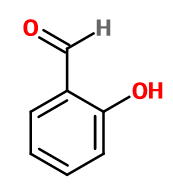
Photo credits: ScenTree SAS
Do you sell any of the raw materials? Would you like to let our users know?
Send an email to fournisseurs@scentree.coto learn about our advertising opportunities.
Do you sell any of the raw materials? Would you like to let our users know?
Send an email to fournisseurs@scentree.coto learn about our advertising opportunities.
General Presentation
-
CAS N° : 90-02-8
-
EINECS number : 201-961-0
-
FEMA number : 3004
-
FLAVIS number : 05.055
-
JECFA number : 897
-
Appearance : Colorless liquid
-
Density : 1,146
-
Volatility : Head/Heart
-
Price Range : €€
Physico-chemical properties
-
Molecular formula : C7H6O2
-
Molecular Weight : 122,12 g/mol
-
Log P : 1,66
-
Fusion Point : 2°C
-
Boiling Point : 197°C
-
Detection Threshold : 30 ppb (0,000003%)
-
Optical rotation : Donnée indisponible
-
Vapor pressure : Donnée indisponible
-
Refractive Index @20°C : Donnée indisponible
-
Acid Value : Donnée indisponible.
-
Flash Point : 78°C
Uses
Uses in perfumery :
Salicylaldehyde is used in warm, almond and coumarinic notes.
Year of discovery :
Data not available.
Natural availability :
Salicylaldehyde is found naturally in small quantities in Ceylon Cinnamon EO.
Isomerism :
The ortho and meta positional isomers of Salicylaldehyde are little used in perfumery, although they also have a bitter almond, very hot, balsamic and sweet smell.
Synthesis precursor :
Salicylaldehyde is the main precursor to Coumarin synthesis by a Perkin reaction with acetic anhydride. It can also form a Schiff base by reaction with Methyl Anthranilate or Indole for example.
Synthesis route :
Salicylaldehyde is synthesized by a Reimer-Tiemann reaction, reacting phenol with potash and chloroform. Then, the aldehyde function implants in the ortho position with respect to the alcohol function.
Regulations & IFRA
Allergens :
This ingredient does not contain any allergen.
IFRA 51th :
This ingredient is not restricted for the 51th amendment


